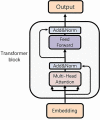PhaTYP: predicting the lifestyle for bacteriophages using BERT
- PMID: 36659812
- PMCID: PMC9851330
- DOI: 10.1093/bib/bbac487
PhaTYP: predicting the lifestyle for bacteriophages using BERT
Abstract
Bacteriophages (or phages), which infect bacteria, have two distinct lifestyles: virulent and temperate. Predicting the lifestyle of phages helps decipher their interactions with their bacterial hosts, aiding phages' applications in fields such as phage therapy. Because experimental methods for annotating the lifestyle of phages cannot keep pace with the fast accumulation of sequenced phages, computational method for predicting phages' lifestyles has become an attractive alternative. Despite some promising results, computational lifestyle prediction remains difficult because of the limited known annotations and the sheer amount of sequenced phage contigs assembled from metagenomic data. In particular, most of the existing tools cannot precisely predict phages' lifestyles for short contigs. In this work, we develop PhaTYP (Phage TYPe prediction tool) to improve the accuracy of lifestyle prediction on short contigs. We design two different training tasks, self-supervised and fine-tuning tasks, to overcome lifestyle prediction difficulties. We rigorously tested and compared PhaTYP with four state-of-the-art methods: DeePhage, PHACTS, PhagePred and BACPHLIP. The experimental results show that PhaTYP outperforms all these methods and achieves more stable performance on short contigs. In addition, we demonstrated the utility of PhaTYP for analyzing the phage lifestyle on human neonates' gut data. This application shows that PhaTYP is a useful means for studying phages in metagenomic data and helps extend our understanding of microbial communities.
Keywords: BRET; deep learning; phage lifestyle prediction; virulent and temperate phages.
© The Author(s) 2022. Published by Oxford University Press.
Figures












Similar articles
-
DeePhage: distinguishing virulent and temperate phage-derived sequences in metavirome data with a deep learning approach.Gigascience. 2021 Sep 8;10(9):giab056. doi: 10.1093/gigascience/giab056. Gigascience. 2021. PMID: 34498685 Free PMC article.
-
CHERRY: a Computational metHod for accuratE pRediction of virus-pRokarYotic interactions using a graph encoder-decoder model.Brief Bioinform. 2022 Sep 20;23(5):bbac182. doi: 10.1093/bib/bbac182. Brief Bioinform. 2022. PMID: 35595715 Free PMC article.
-
Accurate identification of bacteriophages from metagenomic data using Transformer.Brief Bioinform. 2022 Jul 18;23(4):bbac258. doi: 10.1093/bib/bbac258. Brief Bioinform. 2022. PMID: 35769000 Free PMC article.
-
Bacteriophage-based techniques for elucidating the function of zebrafish gut microbiota.Appl Microbiol Biotechnol. 2023 Apr;107(7-8):2039-2059. doi: 10.1007/s00253-023-12439-x. Epub 2023 Feb 27. Appl Microbiol Biotechnol. 2023. PMID: 36847856 Review.
-
Shining Light on Human Gut Bacteriophages.Front Cell Infect Microbiol. 2020 Sep 10;10:481. doi: 10.3389/fcimb.2020.00481. eCollection 2020. Front Cell Infect Microbiol. 2020. PMID: 33014897 Free PMC article. Review.
Cited by
-
Globally distributed marine Gemmatimonadota have unique genomic potentials.Microbiome. 2024 Aug 10;12(1):149. doi: 10.1186/s40168-024-01871-4. Microbiome. 2024. PMID: 39123272 Free PMC article.
-
High activity and specificity of bacteriophage cocktails against carbapenem-resistant Klebsiella pneumoniae belonging to the high-risk clones CG258 and ST307.Front Microbiol. 2024 Dec 9;15:1502593. doi: 10.3389/fmicb.2024.1502593. eCollection 2024. Front Microbiol. 2024. PMID: 39717270 Free PMC article.
-
Complete genome sequences of six coliphages isolated from local water systems in the Philippines.Microbiol Resour Announc. 2025 Jan 16;14(1):e0085924. doi: 10.1128/mra.00859-24. Epub 2024 Nov 29. Microbiol Resour Announc. 2025. PMID: 39611800 Free PMC article.
-
"Sichuanvirus", a novel bacteriophage viral genus, able to lyse carbapenem-resistant Klebsiella pneumoniae.BMC Microbiol. 2025 Jan 13;25(1):17. doi: 10.1186/s12866-024-03736-0. BMC Microbiol. 2025. PMID: 39806322 Free PMC article.
-
Characterization and therapeutic potential of newly isolated bacteriophages targeting the most common Salmonella serovars in Europe.Sci Rep. 2025 Mar 29;15(1):10872. doi: 10.1038/s41598-025-95398-9. Sci Rep. 2025. PMID: 40157986 Free PMC article.
References
-
- McGrath S, van Sinderen, et al. . Bacteriophage: Genetics and Molecular Biology. Wymondham, UK: Caister Academic Press, 2007.
-
- Moineau S. Applications of phage resistance in lactic acid bacteria. Lactic Acid Bact 1999;76(1–4):377–82. - PubMed
-
- Brüssow H, Desiere F. Comparative phage genomics and the evolution of siphoviridae: insights from dairy phages. Mol Microbiol 2001;39(2):213–23. - PubMed

